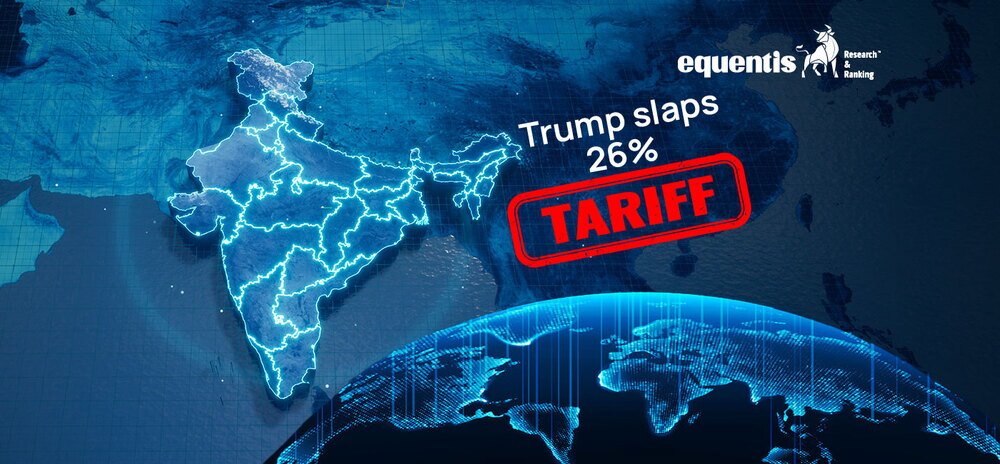On April 2, 2025, U.S. President Donald Trump declared “Liberation Day,” unveiling a series of tariffs aimed at addressing perceived trade imbalances. This initiative introduces a 10% baseline tariff on imports from all countries, with higher reciprocal tariffs targeting specific nations. India faces a 26% tariff on its exports to the U.S., a measure intended to counterbalance India’s 52% tariff on U.S. goods. These tariffs are set to take effect on April 5, 2025. The announcement has prompted varied reactions globally, with concerns about potential economic repercussions and shifts in international trade dynamics. Let’s explore in detail.
Understanding the Tariffs
The newly announced tariffs include a baseline 10% levy on all U.S. imports, with higher rates for specific countries based on existing trade imbalances. India faces a 26% tariff, reflecting the U.S. administration’s view of India’s 52% cumulative tariff on U.S. goods. Other affected countries include China (34%), Vietnam (46%), Japan (24%), and the European Union (20%).
India-U.S. Trade Overview
The United States is India’s largest export market, making this tariff policy particularly impactful. The India-U.S. trade relationship has grown steadily over the years, with bilateral trade reaching approximately $118.2 billion in FY24. India’s exports to the U.S. totaled $77.5 billion, while U.S. exports to India stood at $40.7 billion, resulting in a trade surplus of $36.8 billion in favor of India.
Source: Livemint
Key Export Sectors from India to the U.S.:
- Pharmaceuticals: $10.89 billion (14% of total exports)
- Gems and Jewelry: $10.19 billion (13.2%)
- Petroleum Products: $2.88 billion (3.7%)
- Telecom Instruments: $2.2 billion (2.8%)
- Ready-made Garments: $1.8 billion (2.3%)
- Auto Components: $1.4 billion (1.8%)
- Iron and Steel Products: $1.2 billion (1.6%)
While these sectors form the backbone of India’s export market to the U.S., the new tariffs could significantly impact competitiveness, especially in industries like gems and jewelry, petroleum, and electronics, which already face price-sensitive demand.
U.S. Exports to India:
- Crude Oil and LNG: $11.6 billion (28.5% of total U.S. exports to India)
- Aircraft and Aerospace Equipment: $4.9 billion (12.0%)
- Precious Metals (Gold & Silver): $4.2 billion (10.3%)
- Electrical Machinery: $3.7 billion (9.1%)
- Medical and Optical Instruments: $2.1 billion (5.2%)
The U.S. is also a major supplier of high-tech goods to India, particularly in the defense and energy sectors. The introduction of reciprocal tariffs could lead to price hikes and adjustments in procurement strategies for both countries.
Source: US Import Data
Immediate Market Reactions
Following the tariff announcement, Indian stock markets experienced a downturn. The benchmark Nifty 50 index opened lower, reflecting investor concerns. However, the pharmaceutical sector showed resilience, with stocks rising by 4% due to the exemption of pharmaceutical products from the new tariffs. Companies like Dr. Reddy’s and Gland Pharma saw notable gains.
How Global Markets Reacted
Global markets experienced significant volatility following Trump’s tariff announcement:
- U.S. Markets: Nasdaq futures tumbled 3.3%, with tech stocks hit hard. In after-hours trading, around $760 billion was wiped from the market value of the “Magnificent Seven” tech giants. Apple, which manufactures iPhones in China, fell nearly 7%.
- European Markets: The FTSE futures fell 1.6%, while broader European futures declined by nearly 2%.
- Asian Markets:
- Japan’s Nikkei 225 dropped 2.8%, reaching an eight-month low.
- MSCI’s broadest index of Asia-Pacific shares outside Japan fell over 1%.
- China’s CSI300 blue-chip index dropped 0.24%, and the Shanghai Composite Index declined 0.1%.
- Hong Kong’s Hang Seng Index slid 1.6%.
- South Korea’s Kospi fell 2%, while Vietnam’s ETF lost more than 8% in after-hours trading.
- Australian markets declined by 2%.
- Japan’s Nikkei 225 dropped 2.8%, reaching an eight-month low.
- Gold and Oil:
- Gold surged to a record high above $3,160 per ounce as investors sought safety.
- Oil prices slumped over 2%, with Brent crude futures falling to $73.24 per barrel.
Source: Money Control
- Gold surged to a record high above $3,160 per ounce as investors sought safety.
Sectoral Impacts in India
- Electronics and Electrical Machinery: This sector, particularly smartphone exports, is vulnerable. Over 50% of India’s electronics exports to the U.S. consist of Apple iPhones assembled in India. Increased duties could make these devices more expensive for U.S. consumers, potentially affecting demand.
- Gems and Jewelry: Accounting for 11.5% of India’s exports to the U.S., this sector may face reduced competitiveness due to higher tariffs, leading to potential declines in export volumes.
- Pharmaceuticals: With an 11% share in exports to the U.S., the exemption from tariffs provides relief, allowing continued market access without additional cost burdens.
- Machinery for Nuclear Reactors: Representing 8.1% of exports, this sector could experience decreased demand due to increased costs for U.S. buyers.
- Refined Petroleum Products: Comprising 5.5% of exports, higher tariffs may reduce competitiveness in the U.S. market, affecting export revenues.
Source: Business Standard
Broader Economic Implications
- Currency Fluctuations: The Indian rupee is expected to weaken, with projections indicating an opening value of 85.70-85.75 per U.S. dollar, compared to 85.4975 in the prior session. This depreciation reflects broader market apprehensions.
- Foreign Investment: Foreign investors sold a net $740.3 million of Indian shares on April 1, signaling reduced confidence amid rising global trade tensions.
- Global Trade Dynamics: The tariffs contribute to escalating trade tensions, potentially disrupting global supply chains and prompting countries to seek alternative markets or renegotiate trade agreements.
Government Response and Negotiations
India’s commerce ministry is analyzing the impact of the 26% tariffs and views the situation as a mixed bag rather than a setback. Negotiations are underway for a trade agreement with the U.S., aiming for a deal by fall 2025.
Source: Economic Times
Conclusion
The 26% reciprocal tariff imposed by the U.S. on Indian imports presents challenges across various sectors, with immediate market reactions highlighting investor concerns. While certain industries like pharmaceuticals may find relief through exemptions, others face increased costs and potential reductions in export volumes. The broader economic implications underscore the importance of ongoing negotiations and strategic adjustments to navigate this evolving trade landscape.
Related Posts
Disclaimer Note: The securities quoted, if any, are for illustration only and are not recommendatory. This article is for education purposes only and shall not be considered as a recommendation or investment advice by Equentis – Research & Ranking. We will not be liable for any losses that may occur. Investments in the securities market are subject to market risks. Read all the related documents carefully before investing. Registration granted by SEBI, membership of BASL & the certification from NISM in no way guarantee the performance of the intermediary or provide any assurance of returns to investors.
How useful was this post?
Click on a star to rate it!
Average rating 0 / 5. Vote count: 0
No votes so far! Be the first to rate this post.
waitfor delay '0:0:5'--
I’m Archana R. Chettiar, an experienced content creator with
an affinity for writing on personal finance and other financial content. I
love to write on equity investing, retirement, managing money, and more.
 Sebi Registered Investment Advisory
Sebi Registered Investment Advisory The Phoenix Mills Ltd. (PDF)
The Phoenix Mills Ltd. (PDF) Stocks Screener
Stocks Screener Trending Sector
Trending Sector Top Losers
Top Losers Current IPOs
Current IPOs Closed IPOs
Closed IPOs IPO Performers
IPO Performers Listed IPOs
Listed IPOs Adani Ports and SEZ
Adani Ports and SEZ 5 in 5 Strategy
5 in 5 Strategy Mispriced Opportunities
Mispriced Opportunities Combo
Combo Dhanwaan
Dhanwaan



















